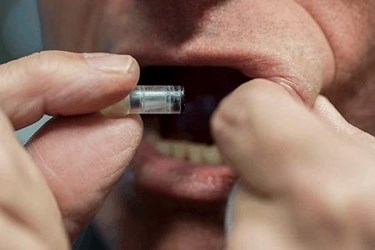Oral Delivery System Could Remove Needles From Vaccines

A novel oral delivery system could one day offer an alternative to injectable vaccines with a pill-sized device that releases a jet stream of water and vaccine molecules into the inner skin of the cheek. A proof-of-concept study conducted by the University of California, Berkeley (UCB), with both pigs and rabbits, demonstrated the technology using egg white proteins.
Molecules in biologic drugs like insulin and many vaccines are much larger than the average chemical-based pharmaceutical — too large to be delivered orally in pill form — and are traditionally administered through subcutaneous injections. For chronic illnesses that require frequent dosages and vaccines that must be administered to small children, needles present a painful and inconvenient problem.
Finding innovative ways to bypassing the needle has become the “holy grail” of pharmaceutical research. In 2014, the CEO of InCube Venture introduced a robotic pill with needles made of sugar, which he claims are capable of delivering biologic drugs; the technology is under investigation , facilitated by a partnership between Rani Therapeutics and Novartis. MIT’s recently launched startup Portal Instruments plans to begin commercializing a needle-free drug-delivery system that will allow patients to self-administer their medications without injections.
The oral delivery system proposed by UCB scientists is not meant to be swallowed, but instead pressed against the inside of the cheek, targeting the buccal region — an area of the body that researchers say is rich in immune cells, but underutilized in currently available treatments. The pill-sized device, which is called MucoJet, delivers the vaccine using a jet stream of that is capable of passing through the thick mucosal layer that oral spray vaccines are unable to penetrate.
Researchers told Berkeley News that the water stream does create some pressure but is virtually painless when compared to a needle injection.
“The jet is similar in pressure to a water pick that dentists use,” said Kiana Aran, who developed the technology as a post-doctoral researcher at UCB and is now an assistant professor at Keck Graduate Institute.
The device can hold up to 250 milliliters of water and 100 milliliters of powdered vaccine in two separate reservoirs. A propellant made of citric acid and sodium bicarbonate is sealed separate from both water and vaccine by a dissolvable membrane. To administer the vaccine, the patient clicks the two compartments together, the membrane dissolves, and the resulting carbon dioxide gas ejects the water and vaccine into the skin of the cheek.
A study published in Science Translational Medicine demonstrated the technology using ovalbumin injected inside the oral cavities of rabbits. Ovalbumin antibodies were present in blood drawn from the rabbits ears up to 6 weeks following their vaccination, six times the amount as the control group that received ovalbumin through droppers.
The device’s ability to elicit antibody production in the buccal region as well as in the rest of the body’s circulating blood, wrote study authors, gives MucoJet the “potential to accelerate the development of noninvasive oral vaccines.”
Researchers are working on different designs and applications of the device, and Aran suggested the placement of the device in a candy would allow parents to administer vaccines at home without having to go to the clinic.
